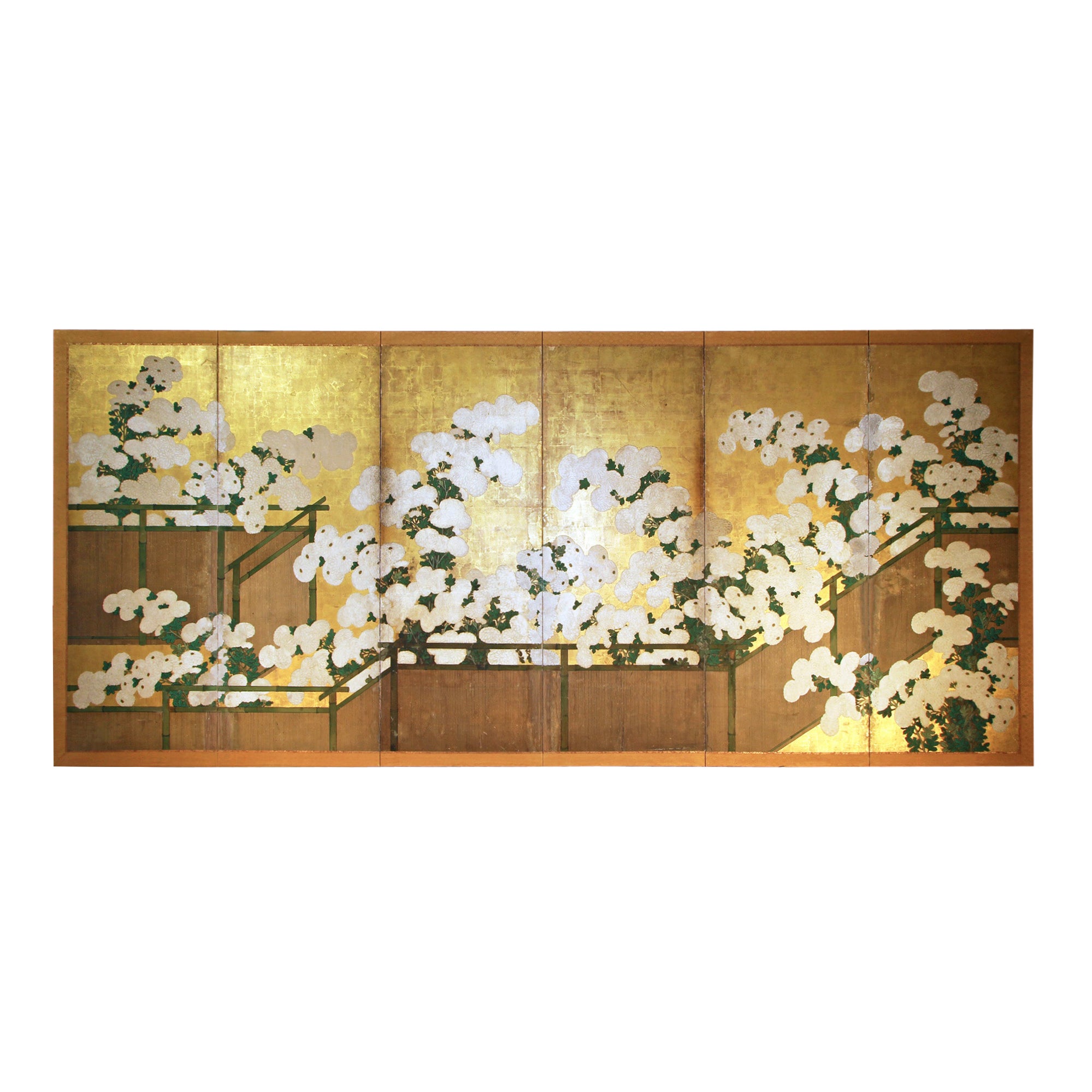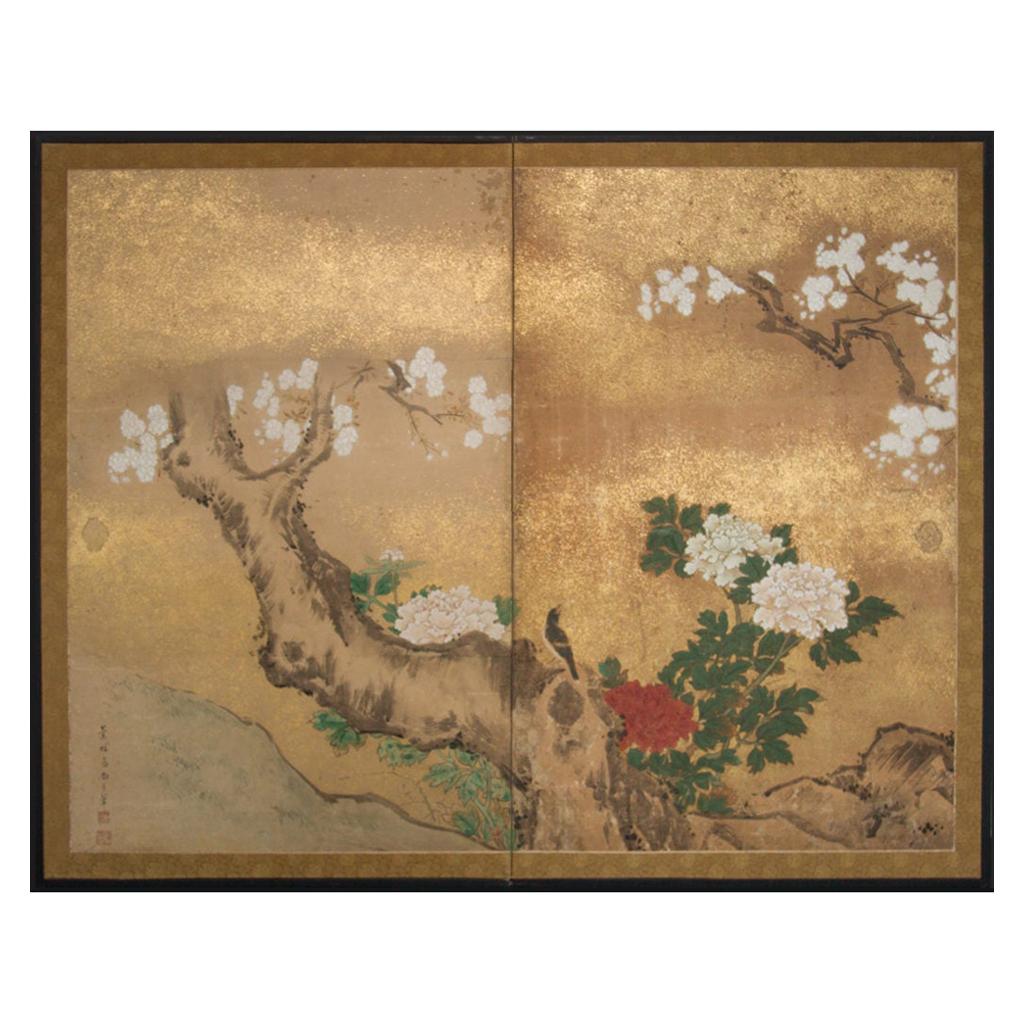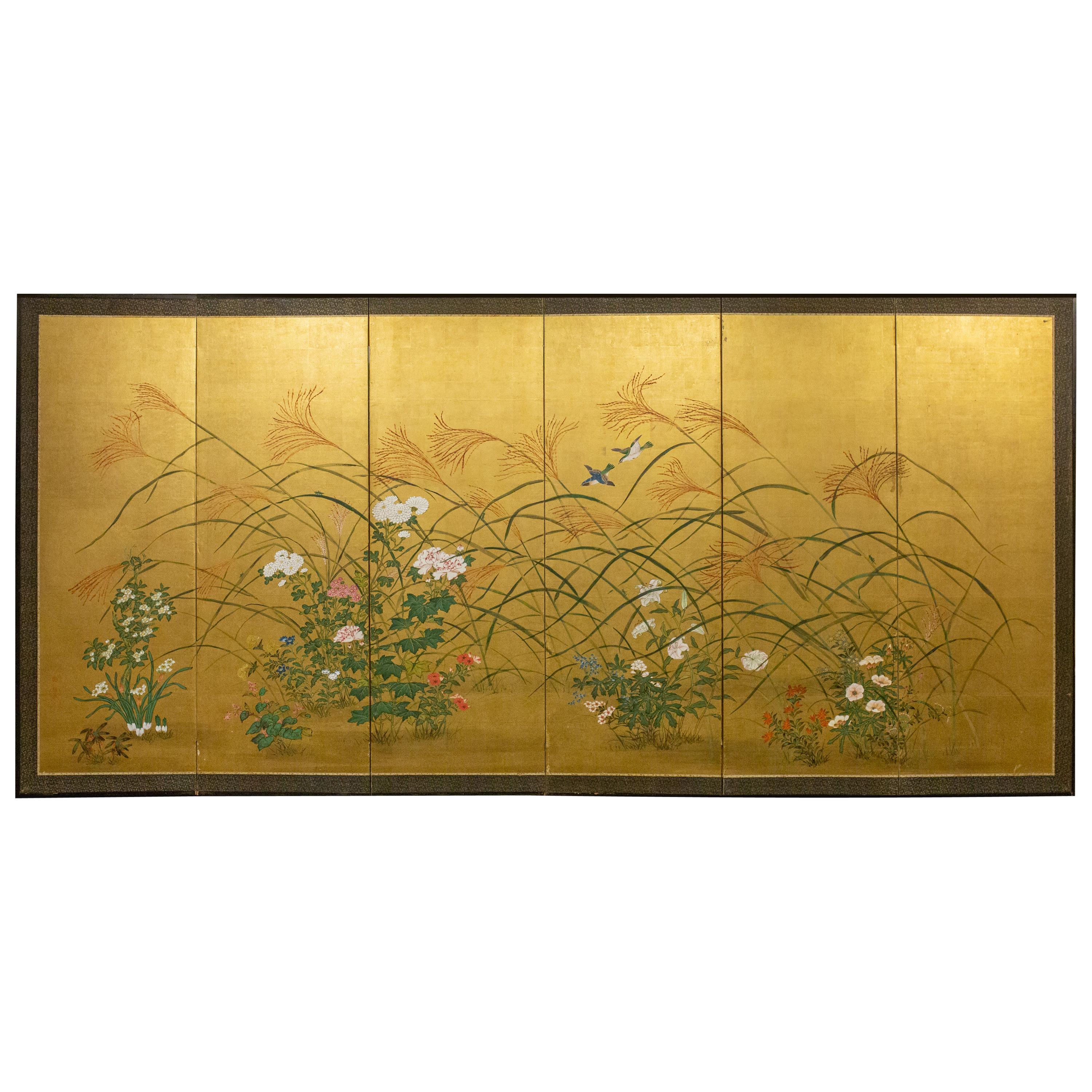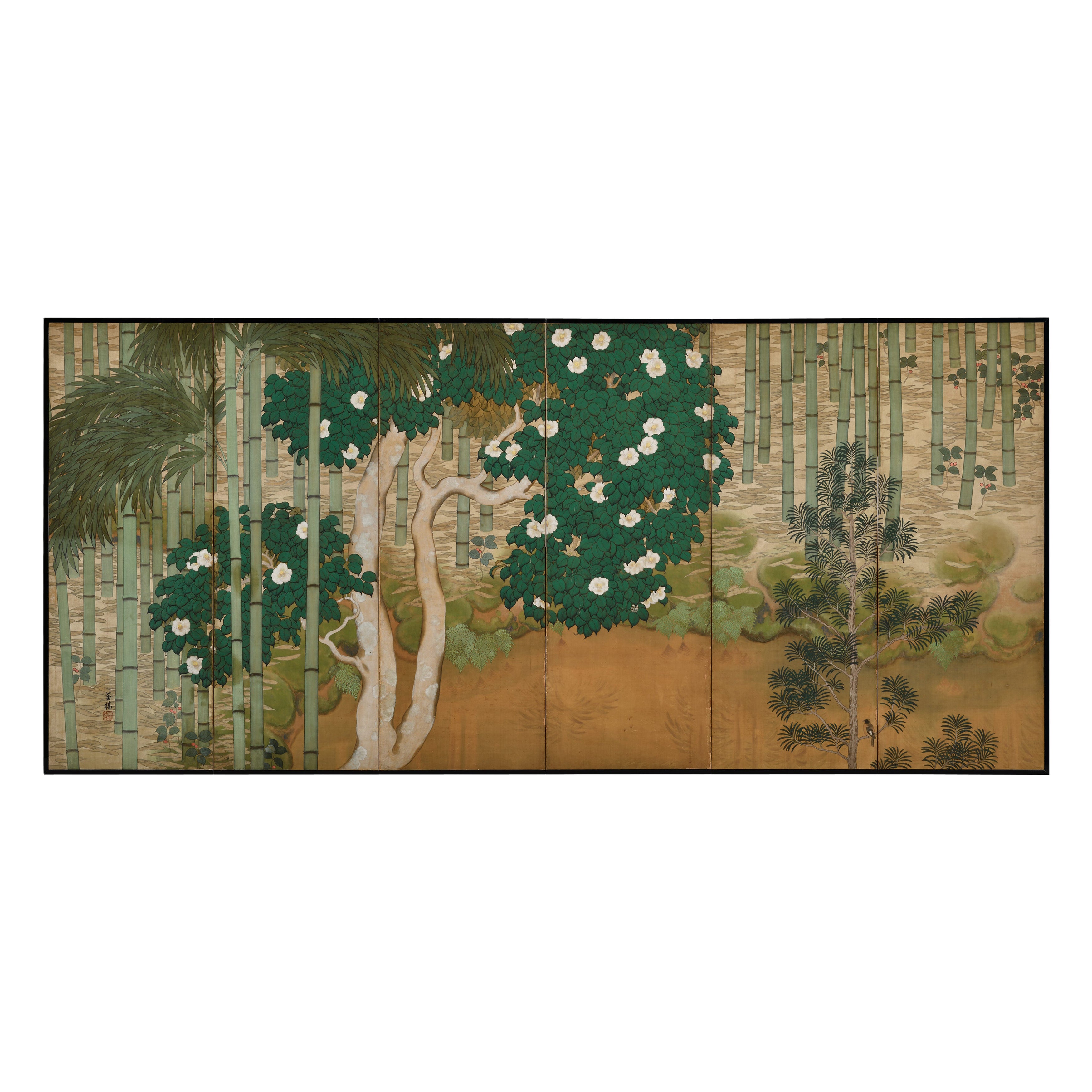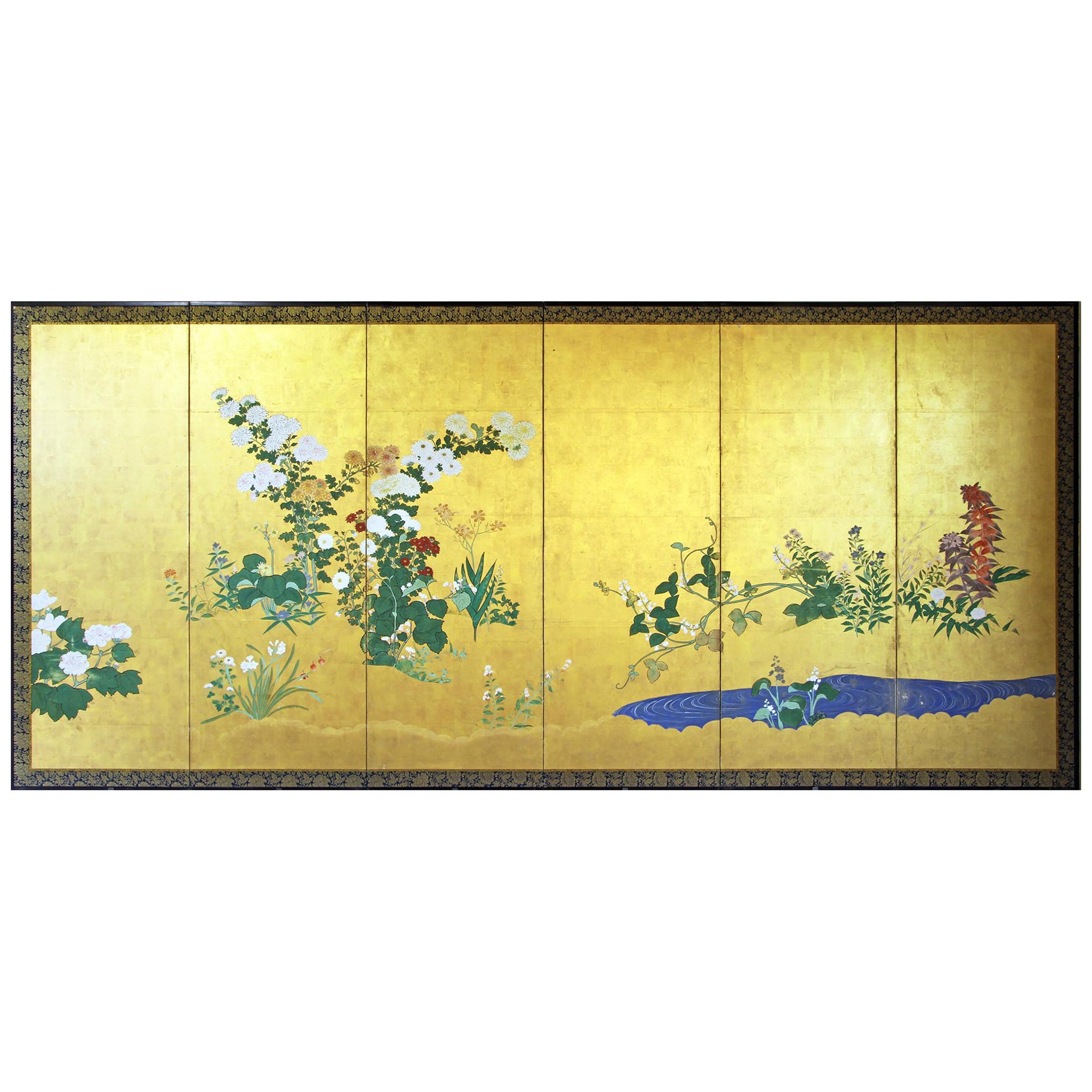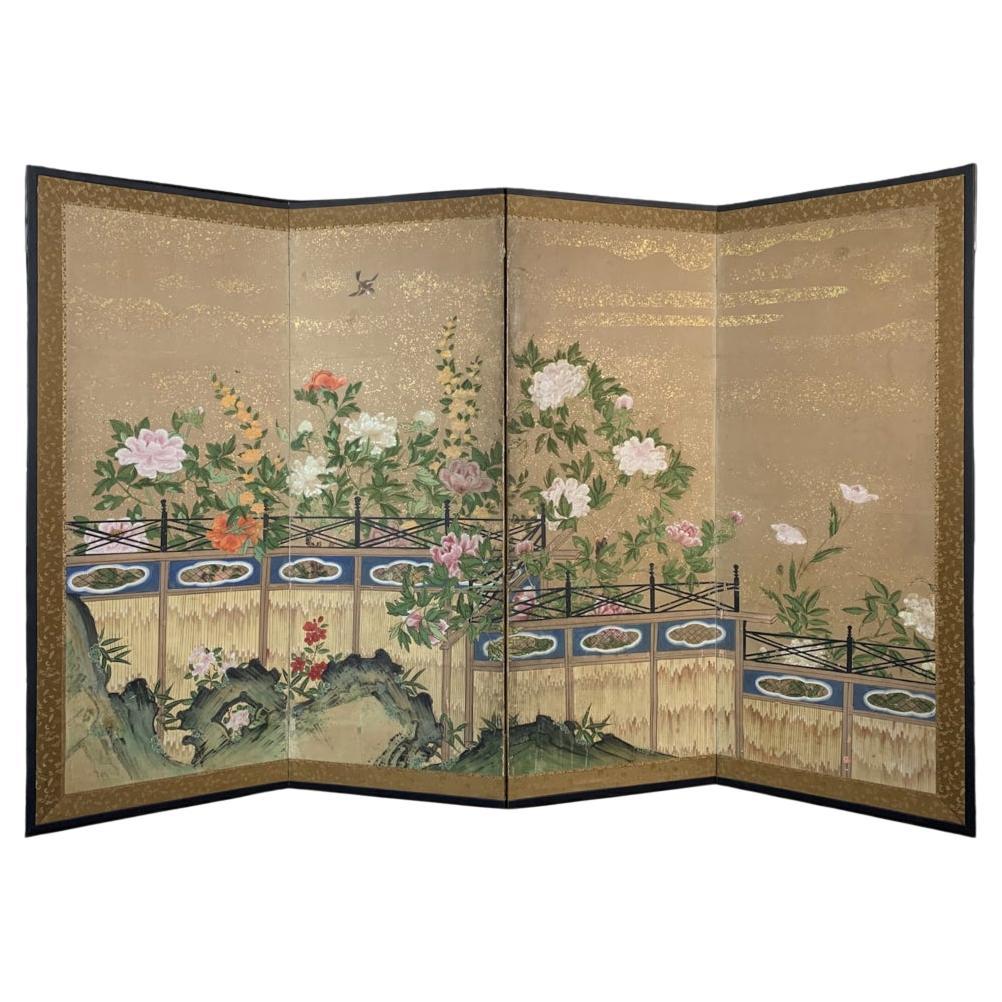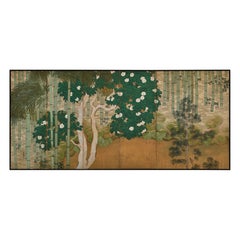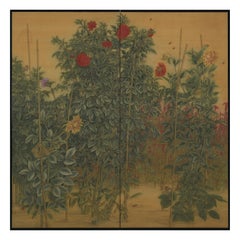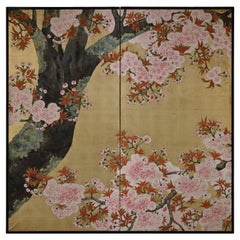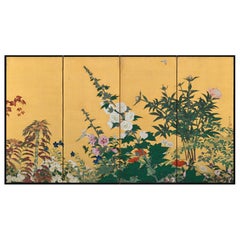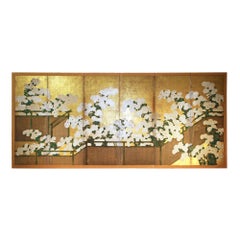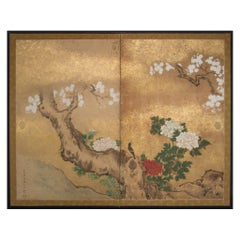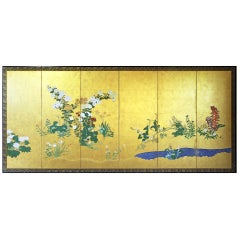Items Similar to Circa 1925. Taisho era Japanese Nihonga Screen. Camellia & Bamboo.
Want more images or videos?
Request additional images or videos from the seller
1 of 7
Circa 1925. Taisho era Japanese Nihonga Screen. Camellia & Bamboo.
$14,800
£11,237.99
€12,851.48
CA$20,677.75
A$22,998.17
CHF 12,008.93
MX$279,863.23
NOK 153,372.34
SEK 143,836.20
DKK 95,915.53
Shipping
Retrieving quote...The 1stDibs Promise:
Authenticity Guarantee,
Money-Back Guarantee,
24-Hour Cancellation
About the Item
Anonymous
Camellia & Bamboo
Taisho era
Two-panel Japanese Screen. Mineral pigment, gofun and ink on silk.
A small Japanese Nihonga screen capturing a moment suspended in time where each element - from the feathery bamboo to the immaculate bloom of the camellia and the brilliant blue water beyond - combine to form a picture of perfect harmony. The fleeting warmth of the winter’s sun is a paradox to the cold, a reminder that even in winter, life thrives and flourishes. The visual contrast between the elements is striking. The Bamboo’s slender and brittle leaves contrast beautifully with the dense, broad leaves and showy flowers of the camellia. Similarly the lush pigments of the deep green camellia foliage and brilliant blue water contrast strongly with the neutral colors of the bamboo, which are largely defined by the natural color of the silk canvas. Known as tsubaki in Japanese, camellia flowers have been revered since ancient times, embodying elegance and resilience. They thrive in the middle of Japan’s harsh winters, especially if they are sheltered from cold winds and frost.
Nihonga, which means “Japanese-style painting,” was a response to the Western influence that was prevalent during the era but aimed to maintain and celebrate Japan’s artistic heritage. Nihonga artists during the Taisho period continued to employ traditional Japanese painting techniques and materials though began to experiment with color palettes, compositions and brush techniques. Nihonga painting often continued the tradition of depicting the beauty of the natural world, with a focus on landscapes, flowers, and birds. Artists combined these themes with modern influences, creating a fusion of tradition and modernity.
The signature reads Fudo and the seal reads Ippu. We are presently unable to find further information relating to the artist.
- Dimensions:Height: 30.5 in (77.47 cm)Width: 68 in (172.72 cm)Depth: 0.75 in (1.91 cm)
- Style:Taisho (Of the Period)
- Materials and Techniques:
- Place of Origin:
- Period:
- Date of Manufacture:Circa 1925
- Condition:Repaired: The screen has recently been fully restored and remounted in Kyoto utilizing traditional craftsmen and techniques. There is some replacement silk and repainting toward the bottom of the hinge. The screen presents beautifully. Wear consistent with age and use.
- Seller Location:Kyoto, JP
- Reference Number:1stDibs: LU2472342272102
About the Seller
5.0
Recognized Seller
These prestigious sellers are industry leaders and represent the highest echelon for item quality and design.
Established in 2001
1stDibs seller since 2016
70 sales on 1stDibs
Typical response time: 6 hours
- ShippingRetrieving quote...Shipping from: Kyoto, Japan
- Return Policy
Authenticity Guarantee
In the unlikely event there’s an issue with an item’s authenticity, contact us within 1 year for a full refund. DetailsMoney-Back Guarantee
If your item is not as described, is damaged in transit, or does not arrive, contact us within 7 days for a full refund. Details24-Hour Cancellation
You have a 24-hour grace period in which to reconsider your purchase, with no questions asked.Vetted Professional Sellers
Our world-class sellers must adhere to strict standards for service and quality, maintaining the integrity of our listings.Price-Match Guarantee
If you find that a seller listed the same item for a lower price elsewhere, we’ll match it.Trusted Global Delivery
Our best-in-class carrier network provides specialized shipping options worldwide, including custom delivery.More From This Seller
View AllEarly 20th Century Japanese Nihonga Screen. Bamboo Forest.
Located in Kyoto, JP
Anonymous
Bamboo Forest
Early Taisho era. Circa 1910-1915.
Six-panel Japanese Screen. Mineral pigment, gofun and ink on silk.
A six-panel Japanese folding screen, painted on silk in...
Category
Early 20th Century Japanese Taisho Paintings and Screens
Materials
Silk
Circa 1920. Taisho era Japanese Nihonga Screen. Dahlias & Cockscomb.
Located in Kyoto, JP
Kawabe Kasho (b.1892)
Dahlias & Cockscomb
Taisho era. Circa 1920
Two-panel Japanese Screen. Mineral pigments and ink on silk.
This exquisite two-panel Japanese folding screen, pa...
Category
Early 20th Century Japanese Taisho Paintings and Screens
Materials
Silk
Early 20th Century Japanese Cherry Blossom Screen by Kano Sanrakuki
Located in Kyoto, JP
Cherry Blossoms
Kano Sanrakuki (1898-1981)
Showa period, circa 1930
2-panel Japanese Screen
Color, gofun and gold leaf on paper
Against a backdrop of gold-leafed ground, the lichen covered trunk and branches of the life-sized cherry blossom tree reach out and beyond the confines of the pictorial surface. The overall composition has a feeling of flatness which draws emphasis to the surface and the three-dimensionality of the cherry blossoms. Painstakingly built-up layers of thickly applied shell-white gofun detail the voluminous blossoms and cover large areas of this tour-de-force of Japanese Nihonga painting. By simplifying the background, minimizing the number of colors and depicting the blossoms with such heavy relief, the artist has emphasized the stunning presence of the cherry tree. The type of tree depicted is the Yae-Zakura; a double-layered type of cherry blossom famed for its beauty and strength. When we think of Japanese cherry blossoms, the first thing that comes to mind is Somei Yoshino variety, which has a single flower with five almost white petals. This type is fragile and easily blown away by strong wind or rain. Most of the double-flowered cherry blossoms begin to bloom when the Somei-Yoshino falls, and the flowering period lasts longer than that of the Somei-Yoshino.
Kano Sanrakuki originally studied painting at the Kyoto City Arts and Crafts School under the tutelage of Yamamoto Shunkyo...
Category
Early 20th Century Japanese Showa Paintings and Screens
Materials
Gold Leaf
Early 20th Century Japanese Screen. Flowers of the Four Seasons.
Located in Kyoto, JP
Anonymous
Flowers of the Four Seasons
A four-panel Japanese screen. Ink, gofun and pigments on gold leaf.
This Japanese screen is a rich visual celebration of the flowers of the fo...
Category
Early 20th Century Japanese Taisho Paintings and Screens
Materials
Gold Leaf
Japanese Screen Painting, Early 19th Century, Autumn Flowers by Sakai Hoitsu
Located in Kyoto, JP
A two-fold Japanese screen by the Rimpa school artist Sakai Hoitsu (1761-1828), Japan, 19th century, Edo period.
This small Japanese folding screen pai...
Category
Antique Early 19th Century Japanese Edo Paintings and Screens
Materials
Wood, Silk
Mid 19th Century Japanese Screen Pair. Flowers & Birds of the Four Seasons.
Located in Kyoto, JP
Shioka Sorin (1781-1850)
Flowers & Birds of the Four Seasons
Pair of six-panel Japanese Screens. Ink, gofun and pigments on silk.
Dimensions (each screen): H. 91.5cm x W. 285cm (3...
Category
Antique Mid-19th Century Japanese Edo Paintings and Screens
Materials
Silk
You May Also Like
Japanese Screen mid Edo gold leaf
By Japanese Studio
Located in Brescia, IT
This 18th century six-panel screen is truly special. The author is unknown, but his singular genius in portraying dozens of chrysanthemum flowers created with the white of the "gofun...
Category
Antique Mid-18th Century Japanese Edo Paintings and Screens
Materials
Gold Leaf
Japanese Two-Panel Screen Peony and Cherry
Located in Hudson, NY
Japanese two-panel screen: Peony and Cherry, Edo period (circa 1800) painting, formerly fusuma (Japanese sliding doors), executed in the Kano school style, featuring a cherry tree in...
Category
Antique Early 1800s Japanese Edo Paintings and Screens
Materials
Gold Leaf
Japanese Six-Panel Screen, a Garden for All Seasons
Located in Hudson, NY
An imaginary garden with flowers from all seasons including spring lilies, summer hibiscuses, autumn chrysanthemums, and winter berries. Wild autumn grasses move in a soft breeze wit...
Category
Antique 1890s Japanese Meiji Paintings and Screens
Materials
Gold Leaf
Edo Landscape Japanese Folding Screen
By Japanese Studio
Located in Brescia, IT
Refined work by a painter from the first half of the 19th century, from the landscape of the "Rinpa" school by a painter from the end of the 18th century, the Rinpa school.
Six panels painted in ink on gold leaf and "gofun" on vegetable paper.
The flowers are made with the "gofun" technique, natural or pigmented white oyster powder.
Rinpa is one of the major historical schools of Japanese painting. The style was consolidated by the brothers Ogata Korin (1658–1716) and Ogata Kenzan (1663–1743).
This folding screen has a very clean design that leaves plenty of room for the beautiful golden landscape.
It comes flat and you can easily hang it with our hooks.
Lucio Morini...
Category
Antique 18th Century Japanese Edo Paintings and Screens
Materials
Gold Leaf
Peony Blossoms Screen
Located in Fukuoka, JP
Peony Blossoms Screen
Period: Edo period 18-19th century
Size: 212 x 138 cm (83.5 x 54.3 inches)
SKU: PJ105
Experience a rare gem from Japan's heritage – an Edo period peony blosso...
Category
Antique 18th Century Japanese Edo Paintings and Screens
Materials
Silk, Paper
Late Edo Period Rinpa School Chrysanthemum Blossom Screen
By Rimpa School
Located in Fukuoka, JP
Late Edo Period Rinpa School Chrysanthemum Blossom Screen
Period: late Edo, early 19th century
Size: 364 x 172 cm (143 x 67 inches)
SKU: PTA13
This exquisite late Edo period Rinpa ...
Category
Antique 18th Century Japanese Edo Paintings and Screens
Materials
Paper
More Ways To Browse
Japanese Brushes
Asian Silk Art Birds
Antique Silk Picture
Japanese Silk Painting Ink
Antique Water Picture
20th Japan Painting On Silk
Asian Screens Green
Small Asian Screens
Mineral Pigments On Silk
Green Japanese Screen
Painted Panel Screen Birds
Japanese Silk Art Landscape
Bird Paintings On Silk
Japanese Silk Screen Flowers
Japanese Brush Painting
Japanese Screen With Birds
Japanese Silk Painting Bird
Japanese Taisho Screen
